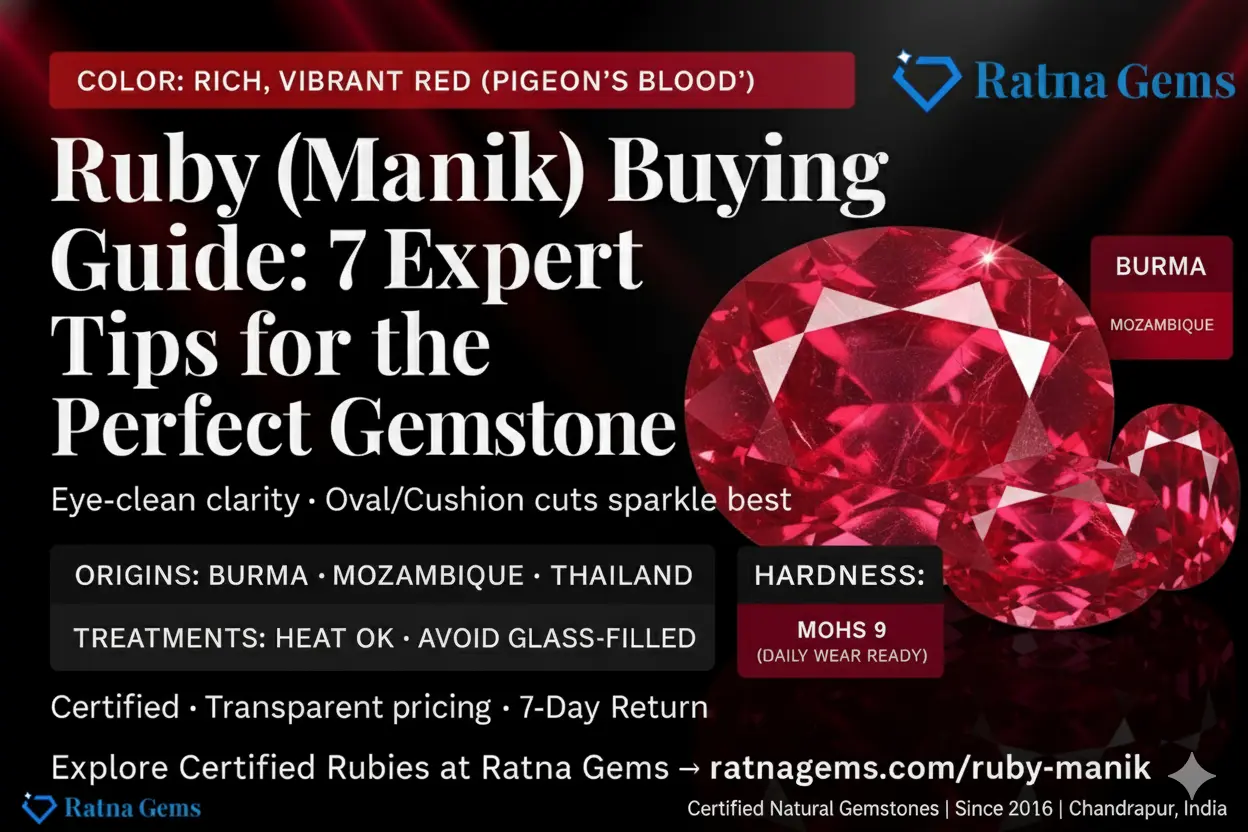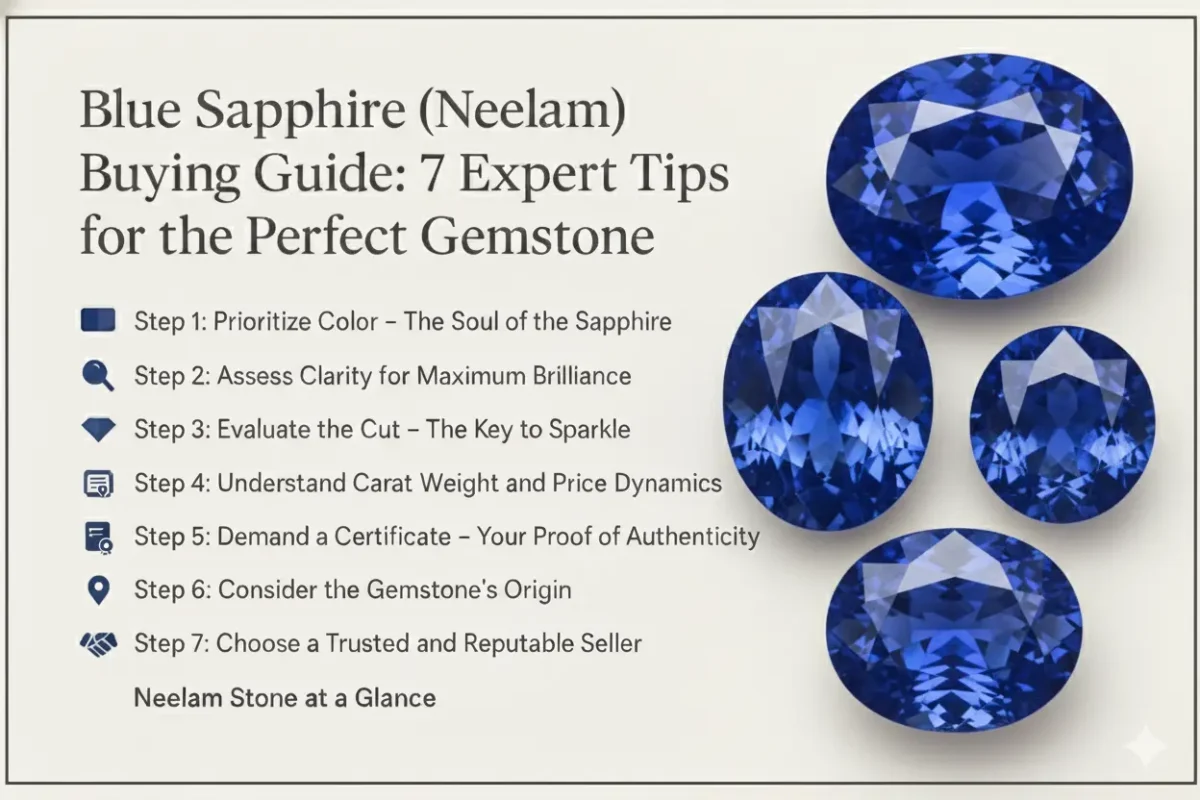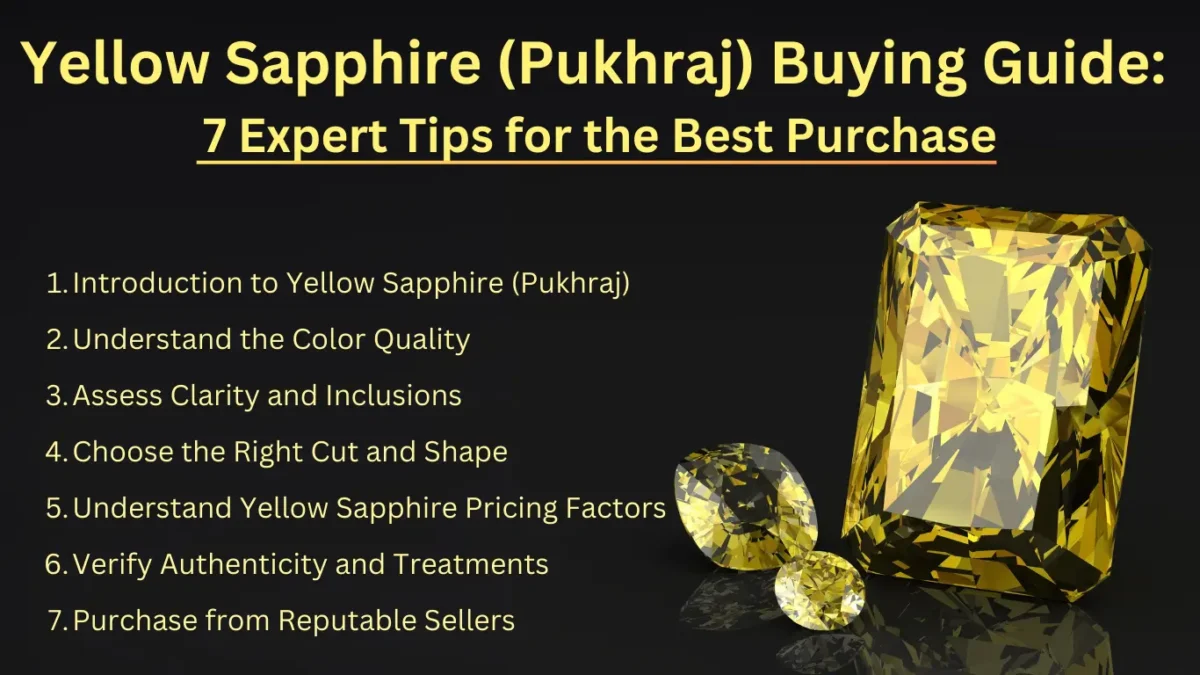Ruby (Manik) Buying Guide: 7 Expert Tips for the Perfect Gemstone
Ruby, the king of gemstones, known in India as Manik, is a symbol of power, passion, and protection. Its fiery red hue has captivated royalty and collectors for centuries. As the primary gemstone for the Sun (Surya) in Vedic astrology, Manik is worn to command authority, boost vitality, and achieve success. Buying a genuine, high-quality Ruby is a significant investment. This expert guide provides in-depth knowledge on how to evaluate its legendary color, understand its different origins, and buy an authentic Ruby stone with complete confidence.

Ruby (Manik) at a Glance
| Gemstone Family | Corundum |
| Indian Name | Manik, Manikya |
| Ruling Planet | Sun (Surya) |
| Metaphysical Properties | Leadership, Vitality, Success |
| Hardness | 9 on the Mohs Scale (Excellent for daily wear) |
The Astrological Significance of Manik and How to Wear It
In Vedic astrology, Ruby is a powerful gemstone for strengthening a weak or afflicted Sun in a horoscope. A strong Sun bestows authority, confidence, and success upon the native.
Astrological Rules for Wearing a Ruby (Manik)
| Who Should Wear It? | Recommended for individuals seeking leadership roles, public recognition, and improved vitality. Especially beneficial for Leo (Simha), Aries (Mesha), and Sagittarius (Dhanu) ascendants. |
| Recommended Carat Weight | Generally, 1/12th of the wearer’s body weight in kg (e.g., a 60kg person could wear a 5-carat Manik). Consultation with an astrologer is advised. |
| Which Finger? | The ring finger of the right (working) hand. |
| Best Metal? | Gold is the most recommended metal. Copper can also be used. |
| When to Wear? | On a Sunday morning during the Shukla Paksha (waxing moon phase). |
How to Buy an Original Ruby Stone: A Step-by-Step Guide
Step 1: Prioritize Color – The King of Factors
Color is the most critical factor in a Ruby’s value. The most coveted color is a pure, vibrant red to a slightly purplish-red. The color should be deeply saturated and not too dark or too light.
Understanding “Pigeon’s Blood” Red: This legendary term refers to the finest color of ruby. It describes a pure, vivid red with a slight hint of purple or blue, and a strong red fluorescence that makes the stone appear to glow from within, even in low light. This color is most famously associated with rubies from Burma (Myanmar).
Step 2: Understand Ruby Origins and Their Characteristics
The origin of a Ruby has a profound impact on its quality and price. While many countries produce rubies, a few stand out.
Comparison of Major Ruby Origins
| Origin | Typical Color | Clarity & Fluorescence | Value |
|---|---|---|---|
| Burmese (Myanmar) | Vivid “Pigeon’s Blood” Red | Often has fine “silk” inclusions; Strong red fluorescence | Highest |
| Mozambique | Brilliant Red to Purplish-Red | Often has higher clarity than Burmese rubies | Very High |
| Thai (Bangkok) | Darker, slightly brownish or purplish red | Lacks strong fluorescence due to high iron content | Moderate |
| African (Tanzania/Madagascar) | Varies from pinkish-red to deep red | Clarity can vary greatly by mine | Varies |
Step 3: Assess the Clarity
Natural rubies are expected to have some inclusions, as completely flawless stones are virtually nonexistent. The key is to find a stone that is “eye-clean.” Fine, intersecting needle-like inclusions of rutile, known as “silk,” can be a positive feature, proving the stone’s natural origin and creating a soft, velvety luster.
Step 4: Examine the Cut and Brilliance
A well-executed cut is essential to maximize a Ruby’s color and brilliance. A skilled cutter will orient the stone to showcase its best red color while minimizing the visibility of inclusions. Oval and cushion cuts are the most common as they preserve carat weight while offering excellent sparkle.
Step 5: Understand Pricing Factors
The ruby stone price increases dramatically with quality and size.
- Color: “Pigeon’s blood” red is the most significant price factor.
- Origin: Burmese rubies command the highest prices, followed by high-quality Mozambique rubies.
- Clarity: Eye-clean stones are much more valuable than heavily included ones.
- Carat Weight: The price per carat for a ruby stone jumps significantly for stones over one carat.
Step 6: Verify Treatments (Heated vs. Glass-Filled)
Most rubies on the market are heat-treated to improve their color and clarity. This is a stable and widely accepted practice.
Crucial Information: Be extremely cautious of rubies that have been “lead-glass filled.” This treatment involves filling surface-reaching cracks with glass to improve apparent clarity. It is not a stable treatment and drastically lowers the stone’s value and durability. A reputable seller will always disclose all treatments.
Step 7: Demand a Certificate and Buy from a Reputable Seller
The only certain way to know a ruby’s origin and any treatments it has undergone is through a certificate from a reputable gemological laboratory. Always purchase from a trusted seller who provides this documentation for every significant ruby gemstone.
Why Trust Ratna Gems™ for Your Ruby?
At Ratna Gems™, we are committed to providing authentic, high-quality astrological gemstones with complete transparency. We are your trusted source because we offer:
- Certified Authentic Rubies: Every Manik is certified by a recognized lab, detailing its origin and treatments.
- Transparent and Honest Pricing: We offer competitive prices for genuine Rubies with full disclosure on quality and origin.
- Unmatched Customer Support: Our experts are here to guide you, and our 7-day return policy ensures your complete satisfaction.
Frequently Asked Questions
Which is the best origin for Ruby?
Historically, Burmese rubies are considered the finest due to their exceptional color and fluorescence. However, high-quality Mozambique rubies are a top modern alternative that can exhibit the same coveted “pigeon’s blood” red.
What is the difference between Ruby and Red Spinel?
Red Spinel is a beautiful gemstone that is often mistaken for Ruby. For centuries, it was considered the same stone. However, Ruby is a corundum (hardness 9) while Spinel is a separate mineral (hardness 8). A gemological lab can easily distinguish them. Rubies are generally more valuable than spinels of similar quality.
What is the difference between a heated and a glass-filled ruby?
Heating is a permanent and stable treatment to improve color, which is widely accepted. Lead-glass filling is a non-permanent treatment where glass is used to fill cracks. A glass-filled ruby is much less valuable and durable, and this treatment must be disclosed.
How should I care for my Manik jewelry?
Clean your Ruby with warm, soapy water and a soft brush. Ultrasonic and steam cleaners are generally safe for untreated or heat-treated stones, but should never be used on glass-filled rubies.






Leave a Comment
You must be logged in to post a comment.